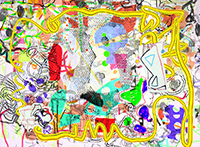Our image this month is no exception, it has a joyfulness and an exuberance which is refreshing from the norm of what we tend to think of as the origins of computer art - that is, a mathematical bias, based on logic or algorithm, which is often geometric in style.
James studied painting at the Royal College of Art and his work straddles the ‘digital/analogue’ divide. He uses computer paint in a painterly, freeform manner which has its roots in abstract and expressionistic art.
He admits his interest is first and foremost in painting, ‘including broad sweeps from its history, that include Persian carpets, Iznik ceramics, Chinese porcelain, early Flemish painting, numerous contemporary painters.’ James says, ‘I like to think a painting can have a life of its own, fascinating the eye with rhythms, patterns of light and dark, shifting colour, contrasts, illusions. And, surprise - finding what you don’t expect.’
For artists within this computer-painting genre, the use of digital tools is not completely defining in their work. In all artworks generally, regardless of medium, there are certain criteria that remain the same.
Indeed in James’ practice, the studio routines, daily drawing exercises and so on continue as he switches back and forth between watercolour, oil and digital paint, building up a stock of motifs and ideas for colour and pattern. He explains, ‘it is quite logical as an artist to use the same idea across several different media, your idea doesn’t change from one to another - it is quite an adventure to keep trying things in different materials.’
James writes that at his first teaching job involving computer graphics (at the RCA, 1989) he had some sceptical students expecting heavy programming. Instead, he explains, ‘I gave them these instructions: Play Around, Don’t Judge, Take Rests. That could also be my philosophy.’
His work is abstract with occasional realistic elements. And in this work containing photographs of painted dots, nothing is quite what it seems. He regularly uses his own photographs as reference points and imagery from old drawing manuals find their way into his works (as in the swirling tendrils here), playing around with thicknesses of lines which he achieves by customising brushes to get all kinds of special effects.
For an artist who works equally proficiently in physical as well as virtual paint, we might consider what the relationship is between the digitally-painted and the traditionally-painted art work.
In James’ own career he has noticed a striking contrast as he moves between the world of non-digital fine art (as represented by the John Moores painting prize for example) and SIGGRAPH (a special interest group of the Association for Computing Machinery and the major venue for showing computer-generated arts).
At SIGGRAPH the exhibitor is required to show the process and code used to create the work, a concept that would be unimaginable in the traditional Fine Art world. James has found that labelling something ‘digital art’ can be problematic when it comes to the art world.
James began using computers to draw in the mid-1980s, and was greatly inspired by the paint systems on the Apple II and the Amiga (programs such as Dazzle Draw, Deluxe Paint). Already established as a painter and critic, (as a co-founder and later editor of Artscribe magazine) he was newly liberated, he says, improvising between screen and canvas: ‘Paint software simulates paint, and (as oil is applied onto a flat surface) paint simulates the screen.’
Although at this time he found the lack of commercial gallery interest in such work frustrating, success arrived when the Victoria & Albert Museum later purchased some of his early digital drawings and subsequently he was shown in Germany (winning the ‘Golden Plotter’ at Computerkunst, 1998) as well as exhibiting at SIGGRAPH for many years and at DAM Berlin and featuring in the acclaimed Digital Pioneers at the Victoria & Albert Museum in 2009, among many others.
James found however that his fellow painters mostly avoided these tools, having a low opinion of computer art.
His book Painting the Digital River: How an Artist Learned to Love the Computer, (Prentice Hall: 2006), was his response and is one of the first to examine in detail an artist’s use of user-friendly Paintbox systems and remains a recommended authority on the subject.
This book argues that painters could use the new palette and still be painters. He also questioned the technological stereotypes of artists who use technology as somewhat apart from the rest of the artistic community - new, weird, bionic, nocturnal even. James argued there was no need to re-invent the roots or change the flavours.
For years he has been a collector of early how-to-draw books and manuals. These, he says, anticipate the draw program: ‘Here we find, in embryonic form, some of the concepts that inform today’s computer-aided visuals.’ James’ method - achieving fluency in digital painting, improvising and making radical changes at speed - means doing without a step-by-step process of weighed decisions or a set of instructions.
He explains, ‘You need sufficient technical mastery to dart this way and that. Those manuals stressed the need for constant practice, and for observing the details of the world around you. They explained materials and methods without jargon, targeting the amateur, the end-user.
Their layout was like the “friendly” interface of the draw and paint programs that emerged in the 80s: toolbox, palette, menu and options.’ As debates about arts education and computer literacy from primary level to undergrad continue, as James suggests, perhaps lessons could be learned today about how to teach drawing and engage the next generation more fully in the creative use of digital tools.
Catherine Mason is the author of A Computer in the Art Room: the origins of British computer arts 1950-80, published in 2008.
More information on the Computer Arts Society, including our events programme
Visit the Computer Arts Society on Facebook
Credit: James Faure Walker, Another Dream of Summer, 80 x 109 cms, archival inkjet print, 2013.
Copyright the artist. Reproduced with permission.


















